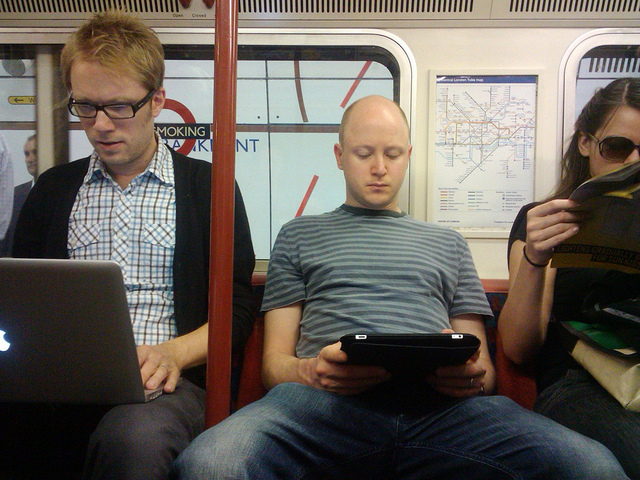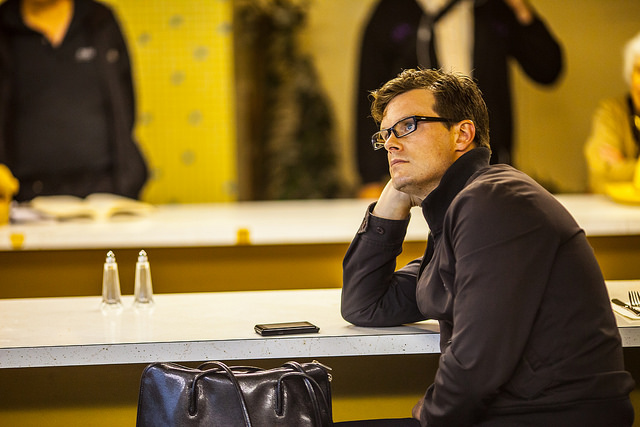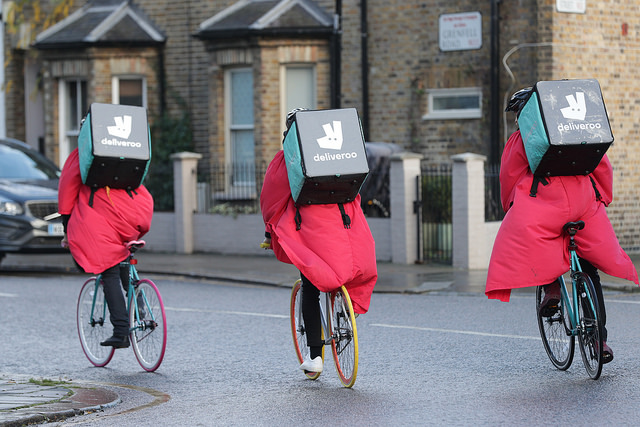Unlock the Magic in Your Story Now
Get the Free 20 questions to Ask Before Launching Your Idea workbook when you sign up for occasional updates.
Get the Free 20 questions to Ask Before Launching Your Idea workbook when you sign up for occasional updates.
Articles filed in: Marketing
Depth Over Reach
filed in Marketing, Storytelling, Strategy
 It’s pouring rain on the morning the free weekly lifestyle magazine is stuck through the railings of every home on every street in our neighbourhood. So the 20% of people who would normally flick through it over morning coffee won’t bother to open the magazine today. The soggy newsprint goes straight into the recycling bin. This is not the story the magazine’s ad sales team will tell prospective advertisers. Their data will talk up the power of building brand awareness and increasing reach as a reliable business growth strategy.
It’s pouring rain on the morning the free weekly lifestyle magazine is stuck through the railings of every home on every street in our neighbourhood. So the 20% of people who would normally flick through it over morning coffee won’t bother to open the magazine today. The soggy newsprint goes straight into the recycling bin. This is not the story the magazine’s ad sales team will tell prospective advertisers. Their data will talk up the power of building brand awareness and increasing reach as a reliable business growth strategy.
The recorded message outside the chiropractor’s office on Victoria Street interrupts every passer-by day or night. He can even reach those making their way home from a big night out at 2 am on Saturday at no additional cost. You just never know who might be walking past at any given moment. And there lies the problem—just like the lifestyle magazine, the chiropractor’s business growth strategy is focused on reach instead of depth. It prioritises the unknowns above the knowns. Both companies have decided that interrupting the most people is the safest marketing strategy. They are ignoring opportunities to deepen relationships with the people who are already interested or invested in their services because they mistakenly believe more is a shortcut to mattering.
How are you prioritising depth over reach in your business?
Image by Alfred Lui.
Don’t Be Afraid To Start Small
 On a rainy Monday early in December 1955, 40,000 African-Americans boycotted the public bus services in the town of Montgomery to protest the arrest of 42-year-old Rosa Parks who refused to give up her seat to a white passenger. Their boycott lasted 381 days until the city repealed its law requiring segregation on public buses. Rosa Parks’ story is one of the most enduring examples we have of the power of one person to change everything.
On a rainy Monday early in December 1955, 40,000 African-Americans boycotted the public bus services in the town of Montgomery to protest the arrest of 42-year-old Rosa Parks who refused to give up her seat to a white passenger. Their boycott lasted 381 days until the city repealed its law requiring segregation on public buses. Rosa Parks’ story is one of the most enduring examples we have of the power of one person to change everything.
We tend to forget that the ‘power of one’ rule also applies to revolutions in the commercial world. Philip Mills choreographed his first barbell workout in the remote city of Auckland, New Zealand in 1990. Today he is the CEO of Les Mills International—the hugely successful global fitness brand, with over 130,000 certified instructors delivering classes to more than 6 million people every week in more than 100 countries around the world. To put that into perspective, the population of New Zealand today stands at 4.5 million.
It’s natural to want to get your product into the hands of everyone who needs it. But thinking about how to influence the masses leads to missteps in understanding what’s driving the decisions of the few people you have the best chance of reaching and impacting right now. Like any revolution, success happens one user, one customer, one raving fan at a time. Never be afraid to start small.
Image by Jasperdo.
Why The Realistic Marketer Wins
filed in Marketing, Strategy, Success
 Marketing shoulders heavy burden in any business regardless of size. We expect our marketing efforts to make more customers aware of our brand and to grab their attention. Not only that, we want our marketing to create trust, differentiate our products, communicate value and change people’s minds. Marketing must also convince strangers to choose us and part with their money. And we want it all to happen as quickly as possible with the minimal investment and effort.
Marketing shoulders heavy burden in any business regardless of size. We expect our marketing efforts to make more customers aware of our brand and to grab their attention. Not only that, we want our marketing to create trust, differentiate our products, communicate value and change people’s minds. Marketing must also convince strangers to choose us and part with their money. And we want it all to happen as quickly as possible with the minimal investment and effort.
This is a big ask, and it’s also the reason we fail when we prioritise tactics over a sustainable marketing strategy.
The realistic marketer doesn’t think this way. He doesn’t believe in quick wins and overnight successes. He obsesses about how to make positive changes in the lives of his customers before crafting clever copy. He learns to question how the people he cares about serving feel before expecting them to act. He puts values before virality and transparency before tactics. The realistic marketer intentionally sets out to make a difference one person at a time. He realises his urgent need does not motivate his potential customers. He understands that delight trumps data every day of the week, so he doubles down on making things people love, instead of trying to make people love the things he makes. The realistic marketer knows that trust scales and belonging is a competitive advantage, which is why he plans to play the long game.
The realistic marketing mindset is open to each one of us. We get to choose our attitudes and actions. It’s worth remembering what we prioritise today changes the impact we make tomorrow.
Image by Christopher Cook.
The Two Questions Behind Every Successful Product And Service
filed in Innovation, Marketing, Strategy
 There’s a subtle difference between a product or service that stems from an idea and one that’s born from recognising an opportunity. Ideas are solutions in search of problems. Opportunities are problems begging for a solution. The magic of solving problems for a specific customer is that the marketing is baked into the product.
There’s a subtle difference between a product or service that stems from an idea and one that’s born from recognising an opportunity. Ideas are solutions in search of problems. Opportunities are problems begging for a solution. The magic of solving problems for a specific customer is that the marketing is baked into the product.
Like many disruptive companies, the team at Dollar Shave Club created a compelling product, innovative business model and viral marketing campaign simply by understanding their customer’s pain points.
We find opportunities when we look for problems to solve, by asking the following two questions:
1. What’s happening that shouldn’t be?
2. What’s not happening, that should be?
In the case of Dollar Shave Club, the answers were clear. The razor blade market was dominated by a few legacy brands who had no direct relationship with their customers. Men were paying a lot of money for shave tech they didn’t need. Buying expensive razor blades didn’t necessarily guarantee a better shaving experience. Shopping for razors and replacing blades wasn’t as convenient as it could be. The startup disrupted the market by addressing these unmet needs.
The utility, quality and success of our products and services improve when we pay attention to what’s missing in our customers’ lives.
What gaps can you fill for your customers?
[Learn more about turning your insights into successful products and services in my new book, Hunch].
Image by Thomas Hawk.
The Number One Way To Create Brand Awareness
filed in Marketing, Storytelling, Strategy
 There was something peculiar about the SoHo hotel where I stayed on my recent overseas trip. I didn’t see a single child for the length of my stay. Nowhere in their marketing does the management specify their property is unsuitable for children and yet because they are uncompromising about going all the way to the edges in everything they say and do—the potential customer knows.
There was something peculiar about the SoHo hotel where I stayed on my recent overseas trip. I didn’t see a single child for the length of my stay. Nowhere in their marketing does the management specify their property is unsuitable for children and yet because they are uncompromising about going all the way to the edges in everything they say and do—the potential customer knows.
The best way to create brand awareness is to make a product or service that’s designed to please a particular audience and to do it without compromising. That’s easy to say and hard to do. When you have two hundred rooms to fill and bills to pay, fear sets in and is closely followed by a compromise. That compromise not only dilutes the potency of your brand, it subconsciously creates a disconnect in the mind and heart of the right customer. You can’t imagine seeing a T-bone steak on the menu at a vegan restaurant. It would never happen under any circumstances. That’s the essence of great branding—to build something that feels like it’s just for a particular kind of person. Someone who wants their choices to reflect their values and to be made to feel like an insider.
Back to the SoHo Hotel. Everything from the size and layout of the guest rooms to beautifully lit communal lounges that doubled as coworking spaces and the items on the menu was intentional. The best way to create brand awareness is to understand who your product is for and to only speak to that person. Awareness isn’t about getting the most people to try your product. It’s about making something the right people fall in love with and can’t help talking about.
What are you doing to make your insiders feel like they belong?
Image by Yann Jouanique.
What Successful Marketers Do
filed in Marketing, News, Strategy
 The restauranteur wants people to feel at home when they dine at his cafe. He furnishes it with a communal table filled with jars of decadent preserves. Diners help themselves to as much as they want without having to ask the wait staff for more.
The restauranteur wants people to feel at home when they dine at his cafe. He furnishes it with a communal table filled with jars of decadent preserves. Diners help themselves to as much as they want without having to ask the wait staff for more.
The technology company wants to make women feel more at ease when they’re buying big ticket electrical items. They understand smells affect consumer behaviour, so orange and vanilla scent is diffused throughout their stores.
The fitness brand knows people are more likely to exercise when it feels less like work. They create an immersive group experience that makes exercising more pleasurable and fun, so members return more often.
Successful marketers act with intention. They deliberately connect strategy and tactics to the outcomes they, and more importantly, their customers, want to achieve. They begin with the end in mind and work backwards.
We have to change how people feel before we can hope to change what they do. We often try to skip this step. It takes courage and time to deliberately connect your brand story to a well thought through strategy—but it’s worth the effort. What end do you have in mind?
Image by Enrique Céspedes
Ten Things Your Competitors Don’t Do

YOUR COMPETITORS DON’T…
1. Obsess about how their products and services make customers feel.
2. Help people to ‘buy in’ and belong (not just to buy).
3. Make something that’s not for everyone.
4. Question how they could do it better.
5. Listen twice as much as they talk.
6. Do what they say they will do.
7. Play the long game.
8. Deliberately delight.
9. Practice empathy
10.Care more
It takes disciplined effort to create meaningful value—but it’s worth it.
Image by Yelp Inc.
Why How We Buy Matters
 Forty years ago when Mr Ryan the greengrocer was thinking about his marketing strategy he didn’t have as much to consider as we do today. His customers were locals. They arrived on foot, only bought what they could carry and shopped every day. It was important to have fresh produce, a ready smile and time to chat and connect. Mr Ryan knew he could often upsell a fresh cream doughnut to Mrs Howard when she came in for a loaf of bread and a quarter pound of ham. In a world before 7-Eleven convenience stores, Mr Ryan didn’t have the challenge of being found. He didn’t have to be more convenient or cheaper. He simply had to open the doors. His marketing strategy was simple. Sell what people are buying when they’re buying it.
Forty years ago when Mr Ryan the greengrocer was thinking about his marketing strategy he didn’t have as much to consider as we do today. His customers were locals. They arrived on foot, only bought what they could carry and shopped every day. It was important to have fresh produce, a ready smile and time to chat and connect. Mr Ryan knew he could often upsell a fresh cream doughnut to Mrs Howard when she came in for a loaf of bread and a quarter pound of ham. In a world before 7-Eleven convenience stores, Mr Ryan didn’t have the challenge of being found. He didn’t have to be more convenient or cheaper. He simply had to open the doors. His marketing strategy was simple. Sell what people are buying when they’re buying it.
Of course, things are very different today. Everything about the business of marketing becomes more nuanced when it’s possible to get a litre of ice cream delivered to your door at midnight, without having cash in your wallet or shoes on your feet. Your customers and clients aren’t as predictable or as transparent as Mr Ryan’s. You have to consider how they buy, not just what and when they buy. You have to go deeper.
How does your customer’s evolving world shape and alter how you do business? How will businesses like yours thrive in the future by meeting not just the wants and needs of customers, but also by understanding their lives, habits and behaviour?
Image by Taylor Herring.
The Patient Marketer
 The couple are examining winter jackets on a rail in the department store when the sales assistant makes a beeline for them. ‘What size are we looking for?’ he says, helpfully. They explain that they’re just looking, but he continues to follow them around offering assistance. So they excuse themselves and leave.
The couple are examining winter jackets on a rail in the department store when the sales assistant makes a beeline for them. ‘What size are we looking for?’ he says, helpfully. They explain that they’re just looking, but he continues to follow them around offering assistance. So they excuse themselves and leave.
Marketing works best when we help people to get what they want when they want it. Trust and timing are an essential part of any marketing strategy, and patience is one of the most useful qualities a marketer can cultivate.
Image by Mike Melrose.
What Are Your Customers Looking For?
 We are sometimes in the dark about what our customers want, so we make assumptions or ask them in the hope of happening upon the truth. There is a third way to get closer to our customers—one we regularly overlook. People’s actions and reactions can reveal more about their internal dialogue than their words. When did you last spend time watching what your customers do?
We are sometimes in the dark about what our customers want, so we make assumptions or ask them in the hope of happening upon the truth. There is a third way to get closer to our customers—one we regularly overlook. People’s actions and reactions can reveal more about their internal dialogue than their words. When did you last spend time watching what your customers do?
As an author, I spend an unhealthy amount of time in bookstores. I’ve lost count of the number of times I’ve seen someone take a thick book from the shelf, feel the heft of it in their hand—then put it back. I can almost hear them thinking they’ll never get through it. Sometimes I get chatting to them and ask them what they’re looking for. Most of the time they don’t know.
Try this. Head down to your nearest department store, cafe, gym or wherever your customers are. Then stand back and watch what they do. Are they feeling garments before they check prices? Are they more likely to make a purchase if they’re alone or with someone? Are they looking for something specific? Do they compare prices with online retailers on their smartphone? Do they buy what they came in for? The list of questions, observations and potential insights are endless.
We tend to think of our customers as intentional, rational human beings—which is why we spend a lot of our time marketing to their heads. We make and market better products and services by working harder to get a glimpse of their hearts.
Image by mgstanton.